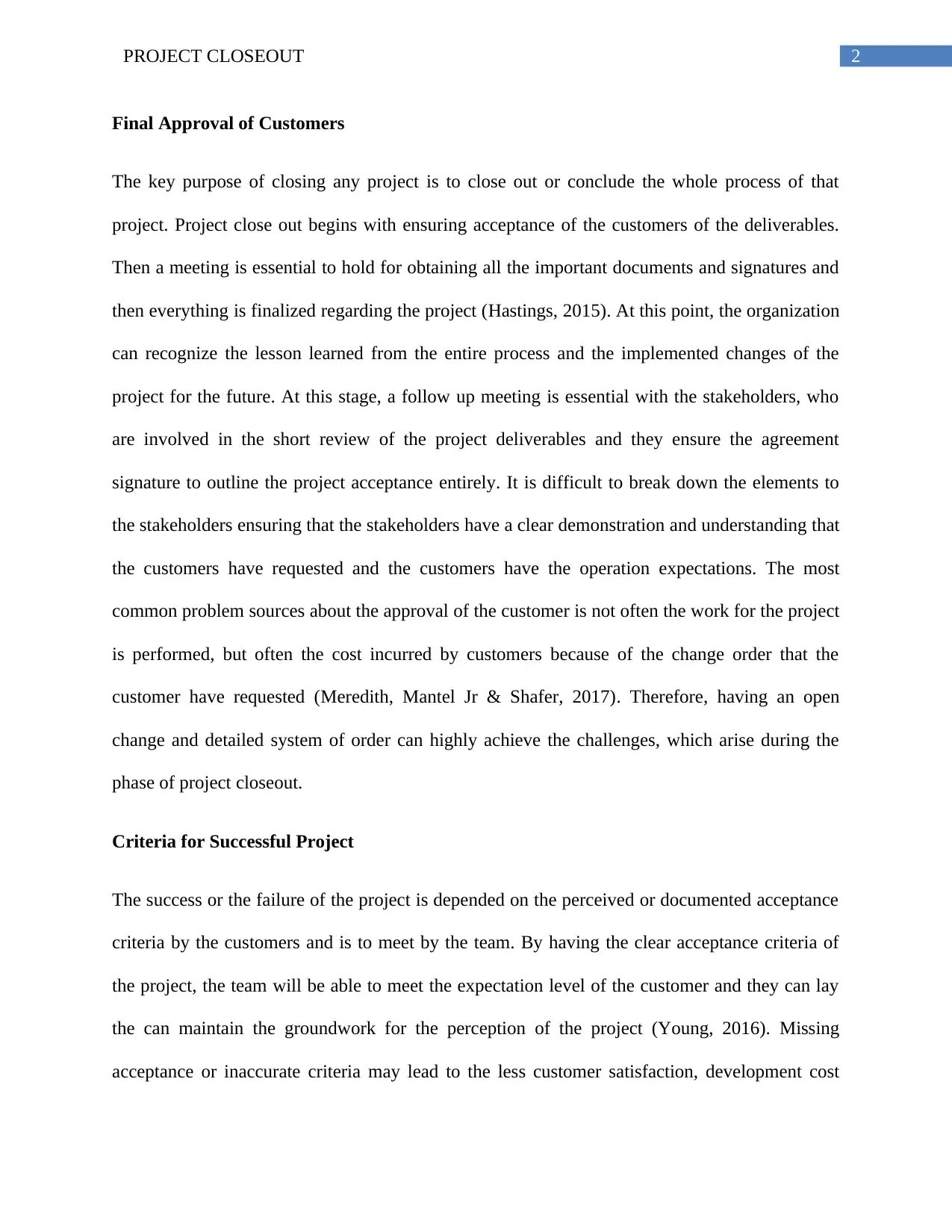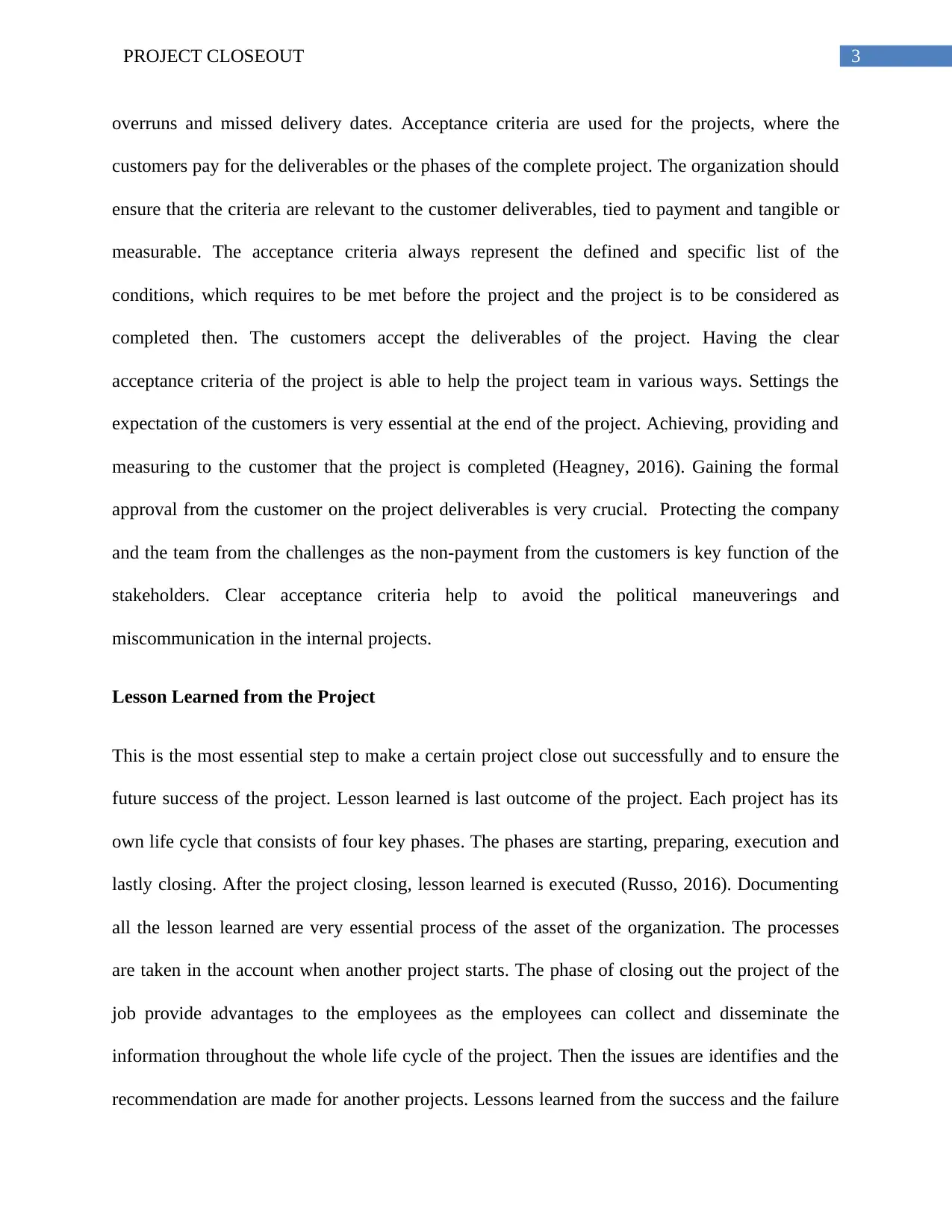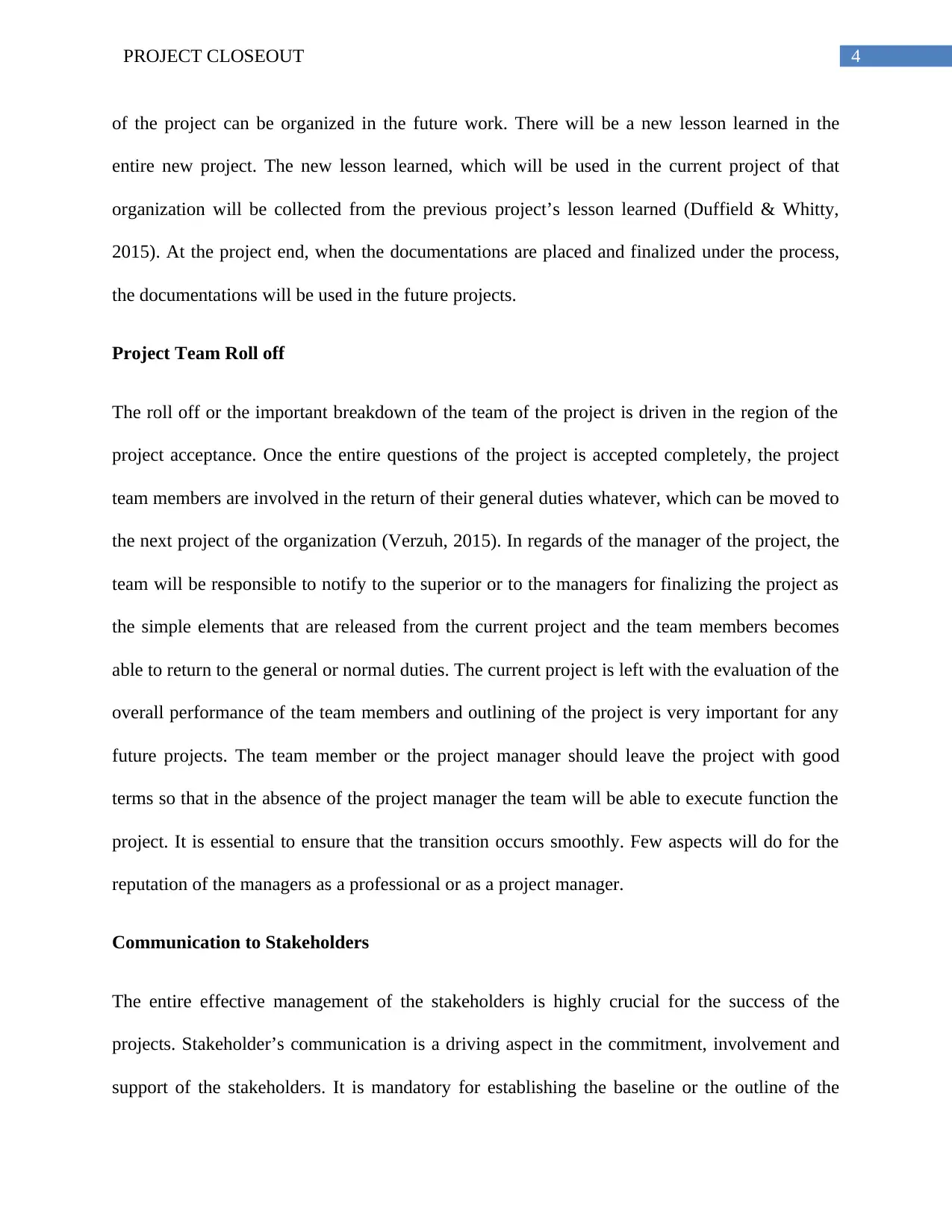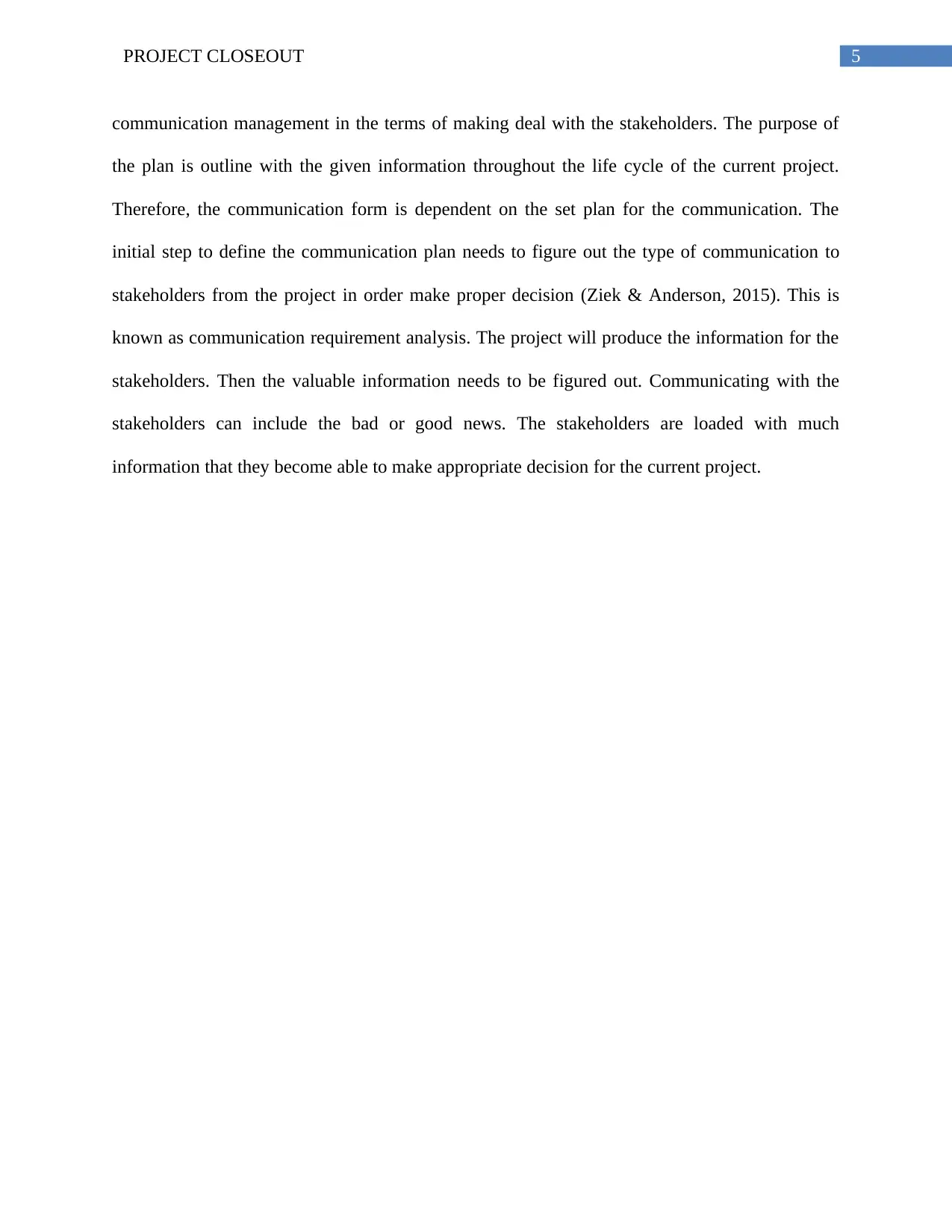Project Closeout Report for Telecommunications Project
VerifiedAdded on 2022/12/23
|6
|1434
|27
Report
AI Summary
This project closeout report details the essential steps for concluding a project successfully. It emphasizes the importance of customer acceptance of deliverables, highlighting the need for clear communication and agreement on project outcomes. The report discusses acceptance criteria, which are crucial for setting customer expectations and ensuring project success, including meeting defined conditions before project completion. Furthermore, it underscores the significance of documenting lessons learned from both successes and failures to improve future project execution. The report also addresses the project team roll-off process, emphasizing smooth transitions and effective communication with stakeholders. The report concludes by stressing the importance of effective stakeholder communication throughout the project lifecycle. The report references key project management principles, including risk assessment, security, and operational considerations. The report also gives a overview of the US military telecommunications equipment and fundamentals of team structure.

1PROJECT CLOSEOUT
Project Closeout
Name of the Student
Name of the University
Author’s Note
Project Closeout
Name of the Student
Name of the University
Author’s Note
Paraphrase This Document
Need a fresh take? Get an instant paraphrase of this document with our AI Paraphraser

2PROJECT CLOSEOUT
Final Approval of Customers
The key purpose of closing any project is to close out or conclude the whole process of that
project. Project close out begins with ensuring acceptance of the customers of the deliverables.
Then a meeting is essential to hold for obtaining all the important documents and signatures and
then everything is finalized regarding the project (Hastings, 2015). At this point, the organization
can recognize the lesson learned from the entire process and the implemented changes of the
project for the future. At this stage, a follow up meeting is essential with the stakeholders, who
are involved in the short review of the project deliverables and they ensure the agreement
signature to outline the project acceptance entirely. It is difficult to break down the elements to
the stakeholders ensuring that the stakeholders have a clear demonstration and understanding that
the customers have requested and the customers have the operation expectations. The most
common problem sources about the approval of the customer is not often the work for the project
is performed, but often the cost incurred by customers because of the change order that the
customer have requested (Meredith, Mantel Jr & Shafer, 2017). Therefore, having an open
change and detailed system of order can highly achieve the challenges, which arise during the
phase of project closeout.
Criteria for Successful Project
The success or the failure of the project is depended on the perceived or documented acceptance
criteria by the customers and is to meet by the team. By having the clear acceptance criteria of
the project, the team will be able to meet the expectation level of the customer and they can lay
the can maintain the groundwork for the perception of the project (Young, 2016). Missing
acceptance or inaccurate criteria may lead to the less customer satisfaction, development cost
Final Approval of Customers
The key purpose of closing any project is to close out or conclude the whole process of that
project. Project close out begins with ensuring acceptance of the customers of the deliverables.
Then a meeting is essential to hold for obtaining all the important documents and signatures and
then everything is finalized regarding the project (Hastings, 2015). At this point, the organization
can recognize the lesson learned from the entire process and the implemented changes of the
project for the future. At this stage, a follow up meeting is essential with the stakeholders, who
are involved in the short review of the project deliverables and they ensure the agreement
signature to outline the project acceptance entirely. It is difficult to break down the elements to
the stakeholders ensuring that the stakeholders have a clear demonstration and understanding that
the customers have requested and the customers have the operation expectations. The most
common problem sources about the approval of the customer is not often the work for the project
is performed, but often the cost incurred by customers because of the change order that the
customer have requested (Meredith, Mantel Jr & Shafer, 2017). Therefore, having an open
change and detailed system of order can highly achieve the challenges, which arise during the
phase of project closeout.
Criteria for Successful Project
The success or the failure of the project is depended on the perceived or documented acceptance
criteria by the customers and is to meet by the team. By having the clear acceptance criteria of
the project, the team will be able to meet the expectation level of the customer and they can lay
the can maintain the groundwork for the perception of the project (Young, 2016). Missing
acceptance or inaccurate criteria may lead to the less customer satisfaction, development cost

3PROJECT CLOSEOUT
overruns and missed delivery dates. Acceptance criteria are used for the projects, where the
customers pay for the deliverables or the phases of the complete project. The organization should
ensure that the criteria are relevant to the customer deliverables, tied to payment and tangible or
measurable. The acceptance criteria always represent the defined and specific list of the
conditions, which requires to be met before the project and the project is to be considered as
completed then. The customers accept the deliverables of the project. Having the clear
acceptance criteria of the project is able to help the project team in various ways. Settings the
expectation of the customers is very essential at the end of the project. Achieving, providing and
measuring to the customer that the project is completed (Heagney, 2016). Gaining the formal
approval from the customer on the project deliverables is very crucial. Protecting the company
and the team from the challenges as the non-payment from the customers is key function of the
stakeholders. Clear acceptance criteria help to avoid the political maneuverings and
miscommunication in the internal projects.
Lesson Learned from the Project
This is the most essential step to make a certain project close out successfully and to ensure the
future success of the project. Lesson learned is last outcome of the project. Each project has its
own life cycle that consists of four key phases. The phases are starting, preparing, execution and
lastly closing. After the project closing, lesson learned is executed (Russo, 2016). Documenting
all the lesson learned are very essential process of the asset of the organization. The processes
are taken in the account when another project starts. The phase of closing out the project of the
job provide advantages to the employees as the employees can collect and disseminate the
information throughout the whole life cycle of the project. Then the issues are identifies and the
recommendation are made for another projects. Lessons learned from the success and the failure
overruns and missed delivery dates. Acceptance criteria are used for the projects, where the
customers pay for the deliverables or the phases of the complete project. The organization should
ensure that the criteria are relevant to the customer deliverables, tied to payment and tangible or
measurable. The acceptance criteria always represent the defined and specific list of the
conditions, which requires to be met before the project and the project is to be considered as
completed then. The customers accept the deliverables of the project. Having the clear
acceptance criteria of the project is able to help the project team in various ways. Settings the
expectation of the customers is very essential at the end of the project. Achieving, providing and
measuring to the customer that the project is completed (Heagney, 2016). Gaining the formal
approval from the customer on the project deliverables is very crucial. Protecting the company
and the team from the challenges as the non-payment from the customers is key function of the
stakeholders. Clear acceptance criteria help to avoid the political maneuverings and
miscommunication in the internal projects.
Lesson Learned from the Project
This is the most essential step to make a certain project close out successfully and to ensure the
future success of the project. Lesson learned is last outcome of the project. Each project has its
own life cycle that consists of four key phases. The phases are starting, preparing, execution and
lastly closing. After the project closing, lesson learned is executed (Russo, 2016). Documenting
all the lesson learned are very essential process of the asset of the organization. The processes
are taken in the account when another project starts. The phase of closing out the project of the
job provide advantages to the employees as the employees can collect and disseminate the
information throughout the whole life cycle of the project. Then the issues are identifies and the
recommendation are made for another projects. Lessons learned from the success and the failure
⊘ This is a preview!⊘
Do you want full access?
Subscribe today to unlock all pages.

Trusted by 1+ million students worldwide

4PROJECT CLOSEOUT
of the project can be organized in the future work. There will be a new lesson learned in the
entire new project. The new lesson learned, which will be used in the current project of that
organization will be collected from the previous project’s lesson learned (Duffield & Whitty,
2015). At the project end, when the documentations are placed and finalized under the process,
the documentations will be used in the future projects.
Project Team Roll off
The roll off or the important breakdown of the team of the project is driven in the region of the
project acceptance. Once the entire questions of the project is accepted completely, the project
team members are involved in the return of their general duties whatever, which can be moved to
the next project of the organization (Verzuh, 2015). In regards of the manager of the project, the
team will be responsible to notify to the superior or to the managers for finalizing the project as
the simple elements that are released from the current project and the team members becomes
able to return to the general or normal duties. The current project is left with the evaluation of the
overall performance of the team members and outlining of the project is very important for any
future projects. The team member or the project manager should leave the project with good
terms so that in the absence of the project manager the team will be able to execute function the
project. It is essential to ensure that the transition occurs smoothly. Few aspects will do for the
reputation of the managers as a professional or as a project manager.
Communication to Stakeholders
The entire effective management of the stakeholders is highly crucial for the success of the
projects. Stakeholder’s communication is a driving aspect in the commitment, involvement and
support of the stakeholders. It is mandatory for establishing the baseline or the outline of the
of the project can be organized in the future work. There will be a new lesson learned in the
entire new project. The new lesson learned, which will be used in the current project of that
organization will be collected from the previous project’s lesson learned (Duffield & Whitty,
2015). At the project end, when the documentations are placed and finalized under the process,
the documentations will be used in the future projects.
Project Team Roll off
The roll off or the important breakdown of the team of the project is driven in the region of the
project acceptance. Once the entire questions of the project is accepted completely, the project
team members are involved in the return of their general duties whatever, which can be moved to
the next project of the organization (Verzuh, 2015). In regards of the manager of the project, the
team will be responsible to notify to the superior or to the managers for finalizing the project as
the simple elements that are released from the current project and the team members becomes
able to return to the general or normal duties. The current project is left with the evaluation of the
overall performance of the team members and outlining of the project is very important for any
future projects. The team member or the project manager should leave the project with good
terms so that in the absence of the project manager the team will be able to execute function the
project. It is essential to ensure that the transition occurs smoothly. Few aspects will do for the
reputation of the managers as a professional or as a project manager.
Communication to Stakeholders
The entire effective management of the stakeholders is highly crucial for the success of the
projects. Stakeholder’s communication is a driving aspect in the commitment, involvement and
support of the stakeholders. It is mandatory for establishing the baseline or the outline of the
Paraphrase This Document
Need a fresh take? Get an instant paraphrase of this document with our AI Paraphraser

5PROJECT CLOSEOUT
communication management in the terms of making deal with the stakeholders. The purpose of
the plan is outline with the given information throughout the life cycle of the current project.
Therefore, the communication form is dependent on the set plan for the communication. The
initial step to define the communication plan needs to figure out the type of communication to
stakeholders from the project in order make proper decision (Ziek & Anderson, 2015). This is
known as communication requirement analysis. The project will produce the information for the
stakeholders. Then the valuable information needs to be figured out. Communicating with the
stakeholders can include the bad or good news. The stakeholders are loaded with much
information that they become able to make appropriate decision for the current project.
communication management in the terms of making deal with the stakeholders. The purpose of
the plan is outline with the given information throughout the life cycle of the current project.
Therefore, the communication form is dependent on the set plan for the communication. The
initial step to define the communication plan needs to figure out the type of communication to
stakeholders from the project in order make proper decision (Ziek & Anderson, 2015). This is
known as communication requirement analysis. The project will produce the information for the
stakeholders. Then the valuable information needs to be figured out. Communicating with the
stakeholders can include the bad or good news. The stakeholders are loaded with much
information that they become able to make appropriate decision for the current project.

6PROJECT CLOSEOUT
References
Duffield, S., & Whitty, S. J. (2015). Developing a systemic lessons learned knowledge model for
organisational learning through projects. International journal of project
management, 33(2), 311-324.
Hastings, N. A. J. (2015). From Concept to Project Approval. In Physical Asset
Management (pp. 61-91). Springer, Cham.
Heagney, J. (2016). Fundamentals of project management. Amacom.
Meredith, J. R., Mantel Jr, S. J., & Shafer, S. M. (2017). Project management: a managerial
approach. John Wiley & Sons.
Russo, C. (2016). Project Closeout and Lessons Learned. In Project Life Cycle Economics (pp.
185-204). Routledge.
Verzuh, E. (2015). The fast forward MBA in project management. John Wiley & Sons.
Young, T. L. (2016). Successful project management. Kogan Page Publishers.
Ziek, P., & Anderson, J. D. (2015). Communication, dialogue and project
management. International Journal of Managing Projects in Business, 8(4), 788-803.
References
Duffield, S., & Whitty, S. J. (2015). Developing a systemic lessons learned knowledge model for
organisational learning through projects. International journal of project
management, 33(2), 311-324.
Hastings, N. A. J. (2015). From Concept to Project Approval. In Physical Asset
Management (pp. 61-91). Springer, Cham.
Heagney, J. (2016). Fundamentals of project management. Amacom.
Meredith, J. R., Mantel Jr, S. J., & Shafer, S. M. (2017). Project management: a managerial
approach. John Wiley & Sons.
Russo, C. (2016). Project Closeout and Lessons Learned. In Project Life Cycle Economics (pp.
185-204). Routledge.
Verzuh, E. (2015). The fast forward MBA in project management. John Wiley & Sons.
Young, T. L. (2016). Successful project management. Kogan Page Publishers.
Ziek, P., & Anderson, J. D. (2015). Communication, dialogue and project
management. International Journal of Managing Projects in Business, 8(4), 788-803.
⊘ This is a preview!⊘
Do you want full access?
Subscribe today to unlock all pages.

Trusted by 1+ million students worldwide
1 out of 6
Related Documents
Your All-in-One AI-Powered Toolkit for Academic Success.
+13062052269
info@desklib.com
Available 24*7 on WhatsApp / Email
![[object Object]](/_next/static/media/star-bottom.7253800d.svg)
Unlock your academic potential
Copyright © 2020–2025 A2Z Services. All Rights Reserved. Developed and managed by ZUCOL.





